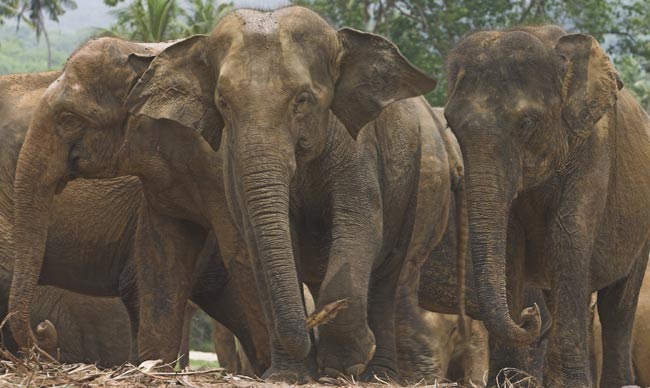Social Networks Rule Among Asian Elephants

Like the high-school prom queen, some female Asian elephants have large social networks, while others are like the wallflower, more isolated, and sticking to a small group of close companions, according to a new study that also found some fickle individuals frequently swapped out their top five friends.
Until now, scientists had considered Asian elephants as staying within random small, isolated groups.
"When you go on a day-to-day basis in the field, you observe relatively small groups of these elephants. Any one [animal] can be seen with any number of individuals. If you don't observe over time, you will think that the associations are very short-lived or even random," study researcher Sergey Kryazhimskiy, of Harvard University, said. "If you observe them long enough, months or even years, individuals associate preferentially with some individuals."
The social network of the population as a whole seems to be consistent across seasons, which is different than the pattern seen in the better-studied African elephants where large population changes are observed.
Elephants in the park
Study researcher Shermin de Silva, of the University of Pennsylvania, collected the data over two years with the help of a team at the Uda Walawe National Park in Sri Lanka. Whenever they came across a group of elephants, they noted which individuals it contained.
At the end of their tracking period, Kryazhimskiy analyzed the data from any animal they had at least 30 sightings of (51 individual elephants). Because male Asian elephants lead solitary lifestyles, the researchers focused on females.
Sign up for the Live Science daily newsletter now
Get the world’s most fascinating discoveries delivered straight to your inbox.
They looked at several levels of organization: the dyad (a pair of elephants), the ego-network (the individuals any one elephant is connected to), and the population as a whole. They saw that some of the more gregarious elephants had many companions, though the relationships were stronger in those with fewer associates. About 16 percent of the elephants changed their top five companions over the course of the study.
Fighting for water
The researchers found that the number of associates each individual had (ego-network level) topped out at around 20, Kryazhimskiy said, and these numbers peaked during the dry seasons. This is most likely a mechanism to deal with decreased resources, specifically water, which each group would need to defend from other groups, though they didn't study this specifically.
"In the wet seasons the resources are much more abundant, and there is no need to form these groups, so the individuals spread out if there is no sort of intrinsic affinity between individuals," Kryazhimskiy suggested, referring to those dyads with strong bonds who stick together even during the resource-abundant wet seasons.
"The study by de Silva et al. makes a significant contribution to our understanding of Asian elephant social organization," Prithiviraj Fernando, a researcher from the Center for Conservation and Research in Rajagiriya, Sri Lanka, told LiveScience in an email. More extensive studies on Asian elephants are still needed, Fernando said, though this can be difficult because they live in low-visibility habitats and avoid people.
This study was published July 26 in the journal BMC Ecology.
You can follow LiveScience staff writer Jennifer Welsh on Twitter @microbelover. Follow LiveScience for the latest in science news and discoveries on Twitter @livescience and on Facebook.
Jennifer Welsh is a Connecticut-based science writer and editor and a regular contributor to Live Science. She also has several years of bench work in cancer research and anti-viral drug discovery under her belt. She has previously written for Science News, VerywellHealth, The Scientist, Discover Magazine, WIRED Science, and Business Insider.











